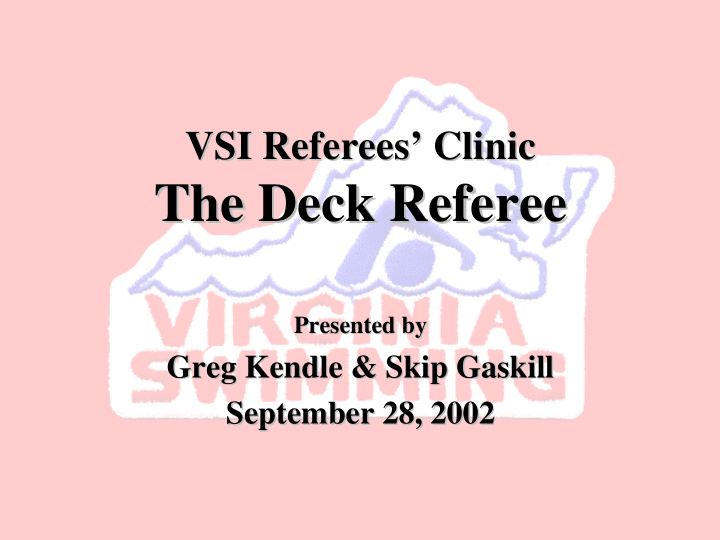



VSI Referees’ Clinic VSI Referees’ Clinic The Deck Referee The Deck Referee Presented by Presented by Greg Kendle & Skip Gaskill Greg Kendle & Skip Gaskill September 28, 2002 September 28, 2002
Timer Briefings for Starters • Make certain the Chief Timer is experienced • Thank lane timers for volunteering • Identify first time lane timers – Don’t allow two inexperienced Lane Timers work together • Explain procedures (Read from the “Lane Timers Briefing Sheet”) – Timers MUST see touchpad to push button or stop their watch. – Make a note of anything unusual. – ALWAYS ask the swimmer to tell you their name. NEVER ask the swimmer if their name is “XXXXX”
Timer Briefings for Starters • Identify situations which may cause confusion – 25s (in which either swimmers or Lane Timers switch ends) – Count the laps. (Lane timing is very social, but don’t forget that your primary responsibility is to help certify the swimmer’s time Pay attention and count the laps. Don’t become confused.) • Discuss relief procedures – Don’t just hand the watch/button to the relief timer and then depart – Be certain the Chief Timer is aware of the relief. • Thank them again for volunteering
Starting Issues • False Starts – When do you recall? • False Start vs. Bad/Unfair Start – Dual confirmation • Starter initiates – What constitutes a false start or bad/unfair start? • Missed Heats – Delay of meet • Not paying attention • Legitimately detained – Mixing sexes and/or ages – Lane separation requirement
Starting Issues • Distance Events – Count the laps • All lanes – Where’s the bell? • Mixed heats • Swimmers with Disabilities – Blind & Visually Impaired – Deaf & Hard of Hearing – Mentally Impaired – Physical Disabilities – Inform officials ahead of time • Review rules
Stroke & Turn Issues • Recommended Stroke Brief – On VSI Web Site • Jurisdiction – Briefing during Officials’ meeting – Reasons for modification • Number of S&T officials • Venue limitations – Breast & Butterfly • Start/Turn Judge: from blocks until head breaks surface • Stroke/Side Judge: starts with head breaking surface after the start and turns to watching the feet all the way into the wall for a turn or finish and everything in between • Turn Judge: the last stroke into the wall, the turn, and from the wall until head breaks surface • 15 meter mark – Relay take offs
Stroke & Turn Issues • Rotation – Out positions – When do they return? • Balancing the Deck – DQ Log – why & how to use one? – Experience levels – Trainees
Stroke & Turn Issues • Chief Judges – Why & how to use a Chief Judge • Maintain momentum – Venue not conducive to quick movement • Another set of experienced eyes – Is Chief Judge (Cert Ref) authorized to sign DQs? • Strongly recommended that the Deck Referee sign them – Radio Protocol • Recommended Practice
Stroke & Turn Issues • DQ Slips – Fill in form CORRECTLY – avoid challenge • Confirm swimmers’ names! (Radios help!) • Fill out neatly, completely, & accurately • Include team name • Circle appropriate stroke • Check appropriate violation • Individual Medley – Turn vs Finish of stroke?
Stroke & Turn Issues • DQ Slips (continued) – Fill in form CORRECTLY (continued) • Notations on Heat Sheet for historical reference • Sign so Referee can identify the Official making the call • Referee will notify the coach • Enter in DQ Log (Who? Ref? TJ? Admin Ref?) – How much description is enough? • Open a can of worms? • Unclear?
Stroke & Turn Issues • Referee Pass Down List – Why? • Issues • Trends • Rationale for decisions • Report of Occurrence – Why? When? – Who gets copies? • Referee • Host Team • Swimmer’s Parents • Swimmer’s Head Coach • Venue Management – Reimbursement of Deductibles
Dealing with Coaches • Lay down the ground rules in the Coaches meeting – Expect coaches to be advocates for their swimmers – Professional enthusiasm is acceptable behavior – Belligerence is not professional enthusiasm – Keep them informed of anything out of the ordinary • Treat them with respect and common courtesy – Have a thick skin when they question a call or decision – Don’t be intimidated – Set a cooperative tone – invite coaches input at any time during the meet
Dealing with Coaches • Difficult/confrontational Coach – Ease the situation out of sight of the audience – Maintain your professional bearing (the moral high ground) – Explain your plan to further investigate the complaint – Be prepared to cut-off discussion and tell coach to write their situation out. – Keep him/her informed of what is going on
VSI Recommended Practices • Administering DQs – Speak to the coach, not to the swimmer • Official’s Attire – Non-Championship meets – Championship meets – Championship meet leadership team • Radio Procedures & Etiquette • Not for chit chat – We are not alone…Others will be listening • Referees should have their own radio with headset • Handling Missed Heats – “Reasonable” accommodation
VSI “Proposed” Recommended Practices • Handling Apprentices at Meets • Handling Coaches at Meetings • Handling Meet Juries • Handling the Pre-Session Meeting • Filling out the DQ Slip
Difficult Stroke Rule Issues • Backstroke – Flip turn • Independent kicks or Non-simultaneous turning action • Your position with regard to the direction the swimmer turned • Breaststroke – Butterfly kick • Feet moving downward as a result of undulation of the body • Knees bending during downward foot motion • Butterfly – Arms • Underwater recovery • Non-simultaneous stroke
Recommend
More recommend